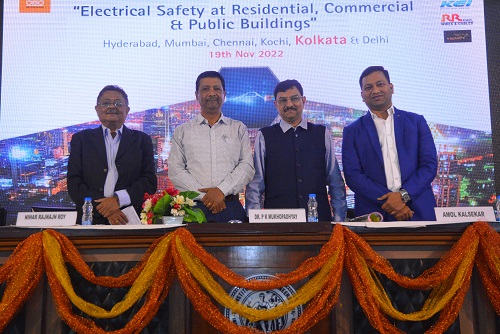Regular Inspections and Adherence to Safety Standards Can Mitigate Electrical Accidents

International Copper Association, India (ICA India), in association with Bureau of Indian Standards (BIS), hosted the 5th session on ‘Electrical Safety at Residential, Commercial & Public Buildings‘ in Kolkata on Saturday. With the support of its product council members such as, Anchor by Panasonic, Finolex, KEI, RR Kabel and V Guard, ICA India laid the foundation of ‘Zero Tolerance‘ initiative in 2018. To further the campaign, ICA India is conducting a series of sessions to drive better cognizance amongst the larger community about the key shortcomings in electrical safety and ways to transition to a safer nation by accelerating adoption of electrical safety standards and compliances for a safer future.
Speakers at the 5th session on “Electrical Safety at Residential, Commercial & Public Buildings”, organized by International Copper Association (India) in Kolkata on Saturday
The topics addressed during the session ranged from role of standardization and periodic inspections to role of wires & cables and transformers in mitigating the incidences of electrical accidents in buildings, earthing and lightening protection.
Contributing his thoughts towards the issue, Dr. Prabir Kumar Mukhopadhyay, Chairman, Institution of Engineers (India) (IEI) said, “Lack of adherence to electrical safety leads to accidents and fatalities. Due to occupational hazards, engineers, electricians, and overhead line workers are the most vulnerable groups exposed to electrical accidents. To safeguard their welfare, regular electrical inspections and strict adherence to safety standards are crucial. We believe, ICA’s national campaign will serve as a powerful platform to discuss the issues related to electrical safety and ensure a robust safety mechanism to save lives and property.“
Elaborating on the subject, Mr. Amol Kalsekar, Chief Manager, International Copper Association India (ICA India) said,“Because of cost pressure, stakeholders always observe provision of bare minimum circuits planned in residential as well as commercial buildings. Over and above this, under sizing of wires & cables further adds to this miserable situation, which often gets converted to electrical hazards like slow poison. We firmly believe that this campaign and the technical sessions will provide industry stakeholders the platform to exchange information and ideas that can act as impetus in the adoption of electrical safety codes and regulations laid out by the Government of India.”
Shri. Nihar Ranjan Roy, Divisional Fire officer for West Bengal Fire & Emergency Services, added, “Mostly 50% of fires are initiated due to electrical faults. Electrical accidents are dangerous, but they can be prevented. Electrical safety is the responsibility of everyone including the builders and the residents. It is crucial to ensure the safety standards are followed in order to minimize the occurrence of such accidents.”
The technical session garnered interest and saw participation from over 70 professionals, an eclectic mix of Electrical Consultants, A Grade Electrical Contractors, Developers & Builders Electrical Engineers, Architects, and various Industry Stakeholders under one roof. The interactive sessions between various stakeholders established the platform for discussion on the need for adoption of ‘zero tolerance’ towards electrical accidents.
Every day in India 11 people die due to fatal electrical accidents. As per the CEA data, a total of 10,022 electrical accidents were reported in India between 2019 – 2020 and 55% of these electrical accidents can be attributed to low voltage electrical installations. On one hand India is one of the fastest growing nations, but on the other hand statistics like these showcase a grim reality about the apparent negligence towards electrical safety.
Some of the major causes of fatal electrical accidents are – inefficient circuit planning in residential as well as commercial buildings, under sizing and inferior quality of wires and lack of periodic electrical inspection. In order to tackle these issues, the Government of India has introduced various electrical standards, codes and regulations, but lack of adherence to the code by relevant stakeholders, as well as lack of understanding among the end users has led us to this inopportune state.
ICA India is a leading advocate for electrical safety on behalf of the copper industry in India, aligned to the government’s goal of transforming into a developed nation by 2047 and electrical safety in commercial and residential buildings is a very important element for the fulfilment of this vision. In line with its commitment to this development goal, ICA India trains around 10,000 electricians and electrical contractors by conducting nearly 200 seminars and workshops annually on “Safe Electrical Installation Practices” with the support of its product council members.
About ICA India (International Copper Association)
The International Copper Association India (ICA India) is a member of Copper Alliance and the Indian arm of the International Copper Association Limited (ICA), the leading not for profit organization for the promotion of copper worldwide set up in 1959. ICA has been operating since 1998 in India and has built an active association with the growing number of copper users through its programs. ICA India Programs are committed to improving the quality of life through better Electrical Safety, Energy Efficiency, Clean Energy and Sustainability. ICA India’s efforts have been pivotal to advancing better standards, across various products, applications and industries, by leveraging upon the superior technical performance of Copper.
About – BIS (Bureau of Indian Standards)
Bureau of Indian Standards (BIS), is the National Standard Body of India established under the BIS Act 2016 for the harmonious development of the activities of standardization, marking and quality certification of goods. BIS has been providing traceability and tangibility benefits to the national economy in a number of ways – providing safe reliable quality goods; minimizing health hazards to consumers; promoting exports and imports substitute; control over proliferation of varieties etc. through standardization, certification and testing.
![]()

